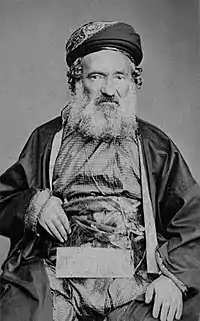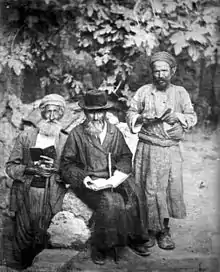Jacob Saphir
Jacob Saphir (1822–1886) (Hebrew: יעקב הלוי ספיר) was a 19th-century writer, ethnographer, researcher of Hebrew manuscripts, a traveler and emissary of the rabbis of Eastern European descent who settled in Jerusalem during his early life.

| Old Yishuv |
|---|
 |
| Key events |
| Key figures |
|
| Economy |
| Philanthropy |
| Communities |
| Synagogues |
| Related articles |
Background
Sapir was born in Ashmyany in the Russian Empire (now Belarus) and immigrated to Israel as a child with his family in 1832. His parents, who were from the Perushim community, settled in Safed. Within a month his father died and a year later his mother died. At the age of 12, he witnessed the attack by the Arabs of the Galilee on the Jews of Safed in the lunar month of Sivan, 1834. Due to the earthquake that occurred in Safed in 1837, he moved to Jerusalem.
In 1848, he was commissioned by the Jewish community of the latter city to travel through the southern countries to collect alms for the poor of Jerusalem. In 1854 he undertook a second tour to collect funds for the construction of the Hurva Synagogue in the Jewish Quarter, which led him in 1859 to Yemen, British India, Egypt, and Australia.
The result of this journey was his momentous ethnographic work, entitled `Even Sapir,[1] a travel diary and vignette of Jewish life and history in Yemen. Saphir published also Iggeret Teman (Wilna, 1868, consciously titled after Rambam's letter of centuries earlier), a work on the appearance in Yemen of the pseudo-Messiah Judah ben Shalom, and which was largely responsible for ending Judah ben Shalom's career. Saphir died in Jerusalem in 1886.
Saphir was the first Jewish researcher to recognize the significance of the Cairo geniza, as well as the first to publicize the existence of the Midrash ha-Gadol, both later studied with great panache by Solomon Schechter.
Sapir also did extensive research and writings on Yanover, Israeli and Greek etrogs. He dedicated a collection of poetry to Sir Moses and Lady Montefiore.[2]
In the years 1833–1885, Saphir helped print the book Ḥemdat Yamim (reprinted Jerusalem 1977) by the arch-poet of Yemen, R. Shalom Shabazi, and even added an introduction to it.
See also
Jewish Encyclopedia bibliography
- Fuenn, Keneset Yisrael, pp. 557–558;
- idem, in Ha-Karmel, vi, Wilna, 1866;
- Geiger, Abraham, in Jüd. Zeit. xi.263-270.
External links
References
- Jacob Saphir, Iben Safir (vol. 1 & 2) Lyck 1866 (Hebrew). [Yesovev ʼAdmat Ḥam (masaʼ Miṛayim) Yam Suf, Ḥadre Teman, Mizraḥ Hodu kulo, ʼErets ha-ḥadashah ʼOsṭralya u-teshuvato ha-ramatah Yėrushalayim. ha-ʼAratsot ʼasher sovavti ṿe-tarti ... matsav ṿe-toʼ ar aḥenu ... ṿeha-mosaʻot ʼotam me-az ʻad ha-yom, ṿe-nilṿah ʼelehem sipurim ṿe-ʻinyanim toranim ṿa-ḥaḳirot ṿe-heʻarot ... ṿe-tsiyune ṿe-reshimot matsevot ʻatiḳot ... ṿe-shire ḳodesh ... / [meʼet] Yaʻaḳov Sapir ha-Leṿi']; Second edition published in Mainz in 1874
- Hirschfeld, Hartwig; Montefiore Library. Jews' College. (1904). Descriptive catalogue of the Hebrew MSS. of the Montefiore Library. London:Macmillan. p. 121. Internet Archive website Retrieved 24 April 2018.
 This article incorporates text from a publication now in the public domain: Singer, Isidore; et al., eds. (1901–1906). The Jewish Encyclopedia. New York: Funk & Wagnalls. Missing or empty
This article incorporates text from a publication now in the public domain: Singer, Isidore; et al., eds. (1901–1906). The Jewish Encyclopedia. New York: Funk & Wagnalls. Missing or empty |title=(help)